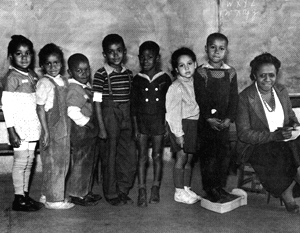
Works Progress Administration
The Works Progress Administration (WPA) was one of the most far-reaching and controversial programs initiated during the New Deal. Designed to put people to work, WPA received an initial Congressional appropriation of $5 billion. Between 1935 and its termination in 1943, the WPA employed approximately 8 million workers and spent $11 billion.
From his headquarters in Nashville, WPA state administrator Harry S. Berry, a World War I artillery commander, launched the Tennessee program. The WPA put thousands of unskilled and semiskilled Tennesseans to work, mainly on the state’s roads. Farm-to-market, rural, and city-street road projects accounted for over 60 percent of total WPA appropriations in the state. But Tennessee WPA workers also built sewer systems, bridges, waterways, dams, viaducts, and overpasses.
Eclectic in the search for worthwhile projects, WPA workers excavated ancient Cherokee earthen mounds and village sites on Hiwassee Island and unearthed a pre-Columbian Indian village near Hurricane Mills. They worked on a community house in Sparta and a home for the poor in Cookeville. Workers built several lakes, including Marrowbone in Davidson County.
Some of Tennessee’s largest WPA projects reflected the arrival of the age of flight. WPA workers helped complete landing fields and airports at Jellico, Cookeville, Lebanon, Jackson, and Milan. They built major airports in Memphis, Chattanooga, Knoxville, Nashville, and at the Tri-Cities of Bristol, Johnson City, and Kingsport.
In Memphis, local political leader Edward H. Crump and U.S. Senator Kenneth D. McKellar dispensed patronage through the WPA. Besides providing extensive road and street work, the WPA employed thousands of men in digging ditches, painting buildings, and resurfacing sidewalks in Memphis. Larger WPA projects included Crump Stadium, the city zoo, a juvenile court building, a new hospital, and several housing developments. When the flood of 1937 swept over the city’s low-lying areas, the damage was lessened by the efforts of thousands of WPA workers who constructed makeshift levees and hastily erected flood walls. WPA employees also helped care for fifty thousand refugees left stranded by the flood, while Nashville WPA workers cared for the five thousand flood victims in that city.
In Nashville WPA workers restored Civil War-era Fort Negley, completed projects at Percy and Edwin Warner Parks, helped construct a new Tennessee Highway Department building, worked at the Hermitage, and refurbished several public schools. These workers also improved city parks, built a city garage and repair building, and completed almost twenty-five miles of street work.
The WPA operated service and arts programs that employed a number of Tennesseans. Adult education classes, public health services, and school lunch programs hired teachers, nurses, and dietitians. In the largest cities the WPA operated women’s sewing and canning classes at domestic training centers and employed writers, actors, artists, and musicians in programs in the arts.
Young Tennesseans also benefited from New Deal initiatives. The National Youth Administration (NYA) offered vocational classes to young fulltime students and employed many others in part-time jobs. NYA youth built shops and vocational buildings in twenty-three counties and gyms and recreational buildings in thirteen others.
Although segregated by race in accordance with the prevailing Jim Crow standards, the NYA and other New Deal programs employed African Americans. Across the South, 750,000 unemployed African Americans worked on WPA projects, and thousands of Tennesseans were put to work this way.
The WPA ran into political trouble in 1938, when charges were made in seventeen states that the agency had used funds to provide financial support for political candidates. In Tennessee, incumbent Governor Gordon Browning claimed that Crump-McKellar-backed candidates had used WPA workers to bring about his defeat in the Democratic primary. Subsequent congressional investigations revealed considerable WPA involvement in the primary as well as other irregularities. In 1939 Congress passed the Hatch Act, which prohibited federal employees from participating in national elections.
Political scandals and the onset of war reduced the support and need for WPA-type employment. Ongoing WPA projects continued until the agency was terminated on June 30, 1943. During its eight years in Tennessee, the WPA employed an average of 30,000 men and women per year. Besides providing desperately needed wages, WPA construction projects built lasting monuments, such as its series of Colonial Revival-style post offices across the state. Among its greatest contributions was a series of state guidebooks produced by the Federal Writers’ Project, including The WPA Guide to Tennessee, an engaging chronicle of the state.
Suggested Reading
James C. Cobb and Michael V. Namorato, eds., New Deal in the South (1985); John D. Minton, The New Deal in Tennessee, 1932-1938 (1979); Carroll Van West, The New Deal Landscape of Tennessee (2001)



